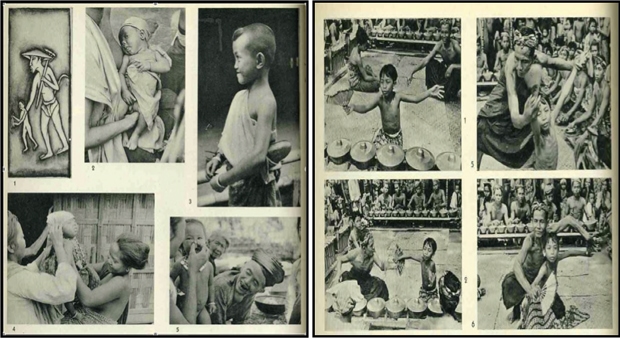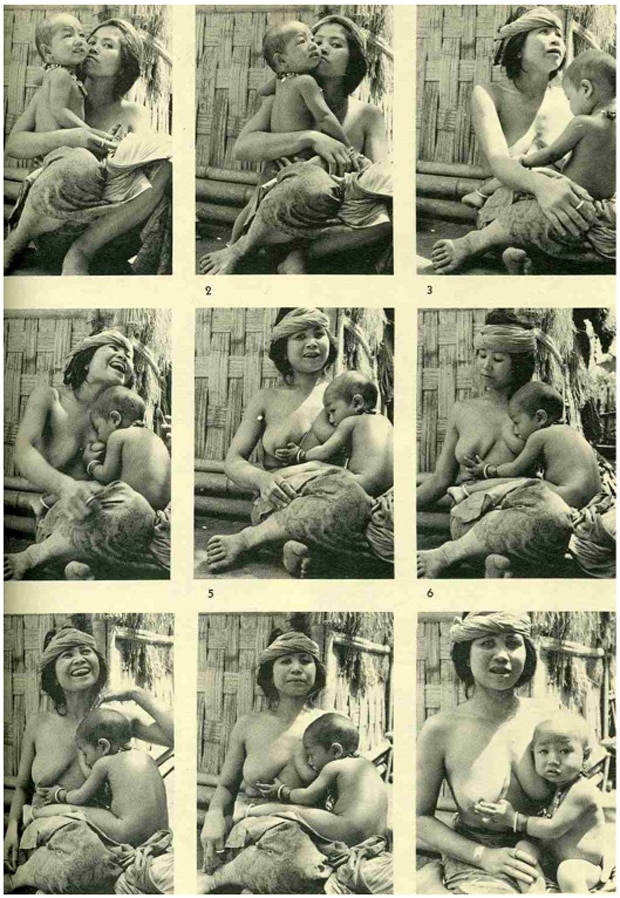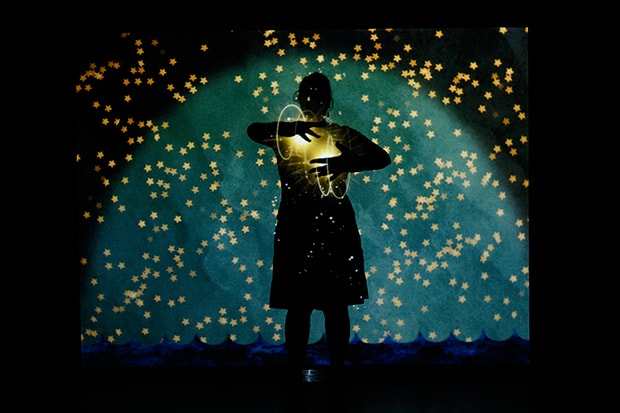Global Methodologies
The result was a work still considered pioneering in visual anthropology and psychological theory; a new method that was also a new form of literacy. Mead and Bateson reproduced this vast archive in a large book, Balinese Character, and in a series of television shows for CBS in the early 1950s. Mead and Bateson hoped to use these large texts and films as part of producing a new form of multimedia literacy: readers were to look for patterns, and make correlations between text and image, between gesture and mind. Balinese Character presents a text for training future anthropologists in a literacy of patterns and re-mediation, organized by gesture and movement, no longer based in written languages. Bateson and Mead had one purpose—the inundation of information that might make the patterns comprising culture visible. Culture could now be made visible through patterned redundancy, not linguistic description.
They made their emphasis on redundancy as a pedagogy quite clear in the introduction to the text: “In this monograph we are attempting a new method of stating the intangible relationships among different types of culturally standardized behavior, spatially and contextually separated.” This statement might be read as a declaration of form, and its prime investment is not descriptive, but rather, to make an “intangible” but performative “relationship” somehow newly visible. By using photographs, they argued, “the wholeness of each piece of behavior can be preserved, while the special cross-referencing desired can be obtained by placing the series of photographs on the same page.” This is part of a new method dedicated to “embody that abstraction which (after we have abstracted it) we technically call culture.”1
Refocusing the attention on ethnography, away from specifics and particularities, they make it clear that facts about a culture, or given taxonomies and ontologies of behaviors, will not be offered. Instead, “patterns” will be made visible. By deduction it is arguable that what Mead and Bateson most clearly want to make visible is not cultural difference, but methodology. They go so far as to render equivalent the concept of culture and the practice of method, by arguing that what is seen in this documentary is a pattern that “embodies an abstraction;” that abstraction—which is comprised of patterns and embodied—they label “culture.” For Mead and Bateson, visualizing and studying culture are analogous. This is a world already fantasized as informationally dense and overly recorded, where language and representation are repressed for the fantasy of an infinite archive of performative actions that render any sense or cognitive process equivalent and visible. These studies demonstrate a compression of seeing, thinking, and acting directly evoked by the assumed legibility of bodily gestures.
Their image work implies a decentered body and subject serving directly to embody a program or sign whose significance emerges not through translation but through finding a repetitive iconography or pattern in the data, as can be seen below (Figure 1), where Mead and Bateson repetitively inundate the viewer with similar actions and gestures to make a point about the embodied nature of the Balinese subject and the autonomous force of non-conscious actions and body parts.

“Teaching by muscular rote in which the pupil is made to perform the correct movements is most strikingly developed in the dancing lesson…
This sequence of photographs illustrates two essential points in Balinese character formation. From his dancing lesson, the pupil learns passivity, and he acquires a separate awareness in the different parts of the body (cf. PL.20, fig.4)”
—Balinese Character, pp.131-32 and pp.86-87
And to make these “patterns” and redundancies visible, Bateson argued that he made the camera an unconscious part of himself. He seemed to desire recording everything (as though all elements of culture were amenable to such capture). He sought to document un-edited gestures and performances, even relinquishing the tripod for a handheld camera, allowing him to move with the action, and anticipating the aesthetics of cinéma vérité. His obsession with these bodily gestures and movements emanated from a belief that the Balinese had neither conflicts nor egos. This strange social and individual psyche could be studied synchronously through these camera techniques.2
Bateson also took thousands of photos. In these images, Bateson steadfastly sought to evoke moments of extreme movement and bodily dissolution. He deliberately repeated in multiple scenarios the same story of acts of touch, and physical excitation, without erotic climax (see Figure 2). These photographs are themselves frustrating. While the subjects return the gaze of the camera and seem to be performing for the ethnographer, Bateson’s style is flat, almost boring. His work lacks an aestheticization of this interaction by way of strong formal qualities such as accenting the subject’s features or emotions, or by integrating dramatic graphic elements of light and shadow, as in the dramatic realist styles of projects such as those of Dorothea Lang and Walker Evans documenting the impact of the Great Depression on Americans, for the Farm Security Administration, at almost the same period, establishing many of the conventions of documentary.
Perhaps more significantly, their work also separated itself from other universal visions of humanity emerging from the same context, such as those finally presented in Edward Steichen’s The Family of Man exhibitions in the 1950s, but that were based on photography done through the 1930s and 1940s, deploying the aesthetics of the WPA. Family of Man was also dedicated to a global and universal pictorial language and operated on the assumption of a vast, infinitely available archive of human experience documented through the camera. But Steichen’s aesthetics encouraged identifying with shared experiences between cultures. This identification is produced through a construction of narrative by way of matching images with texts that are not descriptive but rather complimentary, thus developing a literary and emotional diagetic. Family of Man does not assume a one-to-one correspondence between language and image and between what is said and what is shown, but rather assumes a relationship of interpretation and translation between the visual and the written media. The show also possesses a clear alignment of the gaze through strong graphic elements and explication of viewpoints and events. Family of Man is also temporally progressive. As a show, and later as a book, it was organized according to the imagined normative, heterosexual life cycle of the universal human being.3
Mead and Bateson’s work, on the other hand, lacks time. There is no culminating narrative or normative life cycle organizing the time of these images or films, there is not even a dramatic conclusion to the interactions filmed, nor is there any diegetic narrativization in the whole of the text. Independent moments describe concepts in the culture, but always in a manner that demands continuing to other segments of the text where the same concepts will be regularly repeated (Figures 1 and 2) Mead’s description of Bateson’s photographs is also obsessively informatic and literal. Most importantly, if Steichen’s and others’ projects for global visual languages attempt to formulate correlations and likenesses between cultures in terms of homogeneity, Mead and Bateson affirm the alterity of their study. As Mead states, the forms of love and hate are not dialectically different from our culture, merely “lacking.” (Figure 2)

“STIMULATION AND FRUSTRATION
We have already noted (Pl.38) That the child’s responsiveness is played upon by the mother. In practice this means that the give-and-take of stimulus and response between mother and child lacks the sort of climax structure which is characteristic of love and hate in our own culture. The Balinese mother stimulates her child, but when he responds, she is unresponsive and never allows the flirtation to end in any sort of affectionate climax.”
—From book Balinese Character, Plate 47 (1942) emphasis mine
It should also be noted that the concept of Plateau in Deleuze and Guarrari’s Thousand Plateaus emerged from this Balinese work.
Bateson’s images thus rarely facilitate a normative optic of identification, recognition, or objectification. The spectator is not offered a direct separation or affiliation, but only a “lack” in Mead’s text. This non-identification can also be attributed to the distance and proximity of the image to its subjects. The camera is rarely near enough for the close-up or far enough to offer an establishing shot of the entire environment. This holds true in both the cinematic work and the photography. Since the camera is often moving with the action, or located at distances that remove the figure from the broader surroundings, the result is a perceptual disorientation and a collapse of epistemic control—interestingly enough, at the very site of documentary realism.

The body recorded as a medium, in Bateson’s work, for the production of culture.
—Gregory Bateson and Margaret Mead, Dance and Trance in Bali (1952). Footage shot 1937-39.
This perspective is doubly amplified in Bateson’s film footage because of the extremely long takes and the lack of editing at the time of fieldwork. Retroactively, in 1952 Mead decided to use these films for broadcast on CBS. At this juncture the rather extended takes and the non-event structure of the original films was largely overcome by integrating Mead’s voiceover explaining the action and focusing on dramatic moments in the trance sessions, particularly moments when participants slip between states, suffer moments of tremor and seizure, or actually perform attacks and killings of ghosts, witches, and demons.
It is worth noting, however, that Mead and Bateson had separated at this point. After the war Bateson revisited this work and now found Mead’s approach inappropriate. He was particularly against the voiceover integrated into the films, the voice of authority. He also never returned to intensively using visual, filmic, and photographic methods in his own work, although many working with him did so regularly.4




